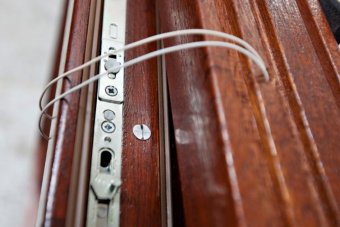We should start with two short statements:
Rules of thumb:
First: There is no fully burglar-proof hardware!
Second: There are no fully burglar-proof windows either!
There is simply no way for the joinery industry to manufacture windows that would guarantee complete security against burglary. We can only discuss windows and hardware that is more or less resistant to intrusion.
So far the fundamental document relating to the issue of hardware burglary resistance is the standard ENV 1627:2006 which establishes 6 window security classes. From the German word “Wiederstandsklasse” (resistance class) it has also become normal to talk in Poland of so-called “WK” classes, for example, WK 1, WK 2. Class 1 is the lowest level of security, class 6 is the highest level of security.
Resistance classes
Burglary resistance class answers the question of how long a window will withstand unauthorised attempts to open it from the outside by using different sets of tools and various forces.
Resistance to burglary is a characteristic resulting from the construction of the windows, as well as with the selection of appropriate materials for a design. Buyers, as well as sellers commonly use the term “burglar-proof”. This is in fact an incorrect and misleading term, because windows that would be 100% burglar-proof do not exist.
Depending on the selection and arrangement of hardware they can belong to different burglary resistance classes. The WK index determines the time needed to force entry through the structure of the window. Three classes of solutions are most prevalent on the market:
- WK1 – a window that cannot be forced using only brute force (without tools);
- WK2 – a window that cannot be forced for 3 minutes using simple tools (screwdriver, pliers, tongs, etc.);
- WK3 – a window that withstands even a steel crowbar for at least 5 minutes.
When choosing one of the types of burglary protection, it is necessary to remember that the hardware itself is not enough. An important element of the whole set of anti-burglary elements is the anti-burglary glass and door handle with a key or button.
If windows with elements inhibiting burglary are chosen, one should also consider equipping the windows with contact sensors. Contact sensors are a simple and effective sensor of open windows and doors that forms part of a security system or access control system. It is important that for a contact sensor to be installed in all windows and doors it protects the building against intrusion attempts at the stage of the attempt, as opposed to motion detectors located inside a building. A contact sensor works on the basis of a magnet and a tube with embedded circuits.

Fot. Kontaktron
Opening the window breaks the electromagnetic circuit. Each sensor is connected to an alarm control panel. When leaving the house, it is not possible to arm the alarm when any window is not closed. Contact sensors are installed at the manufacturing stage of windows.
A similar but much more expensive solution is a contact sensor integrated with circumferential hardware. This also works on the basis of an electric circuit, but with the difference that just a slight manipulation of the hardware or handle is enough to set off the alarm. This system also requires all windows to be closed prior to the alarm being armed.
THE TERM BURGLARY-PROOF IS ONLY RELEVANT WHEN THA WINDOW ITSELF IS CLOSED IN ADDITION TO ANY SAFEGUARDS EMPLOYED.



